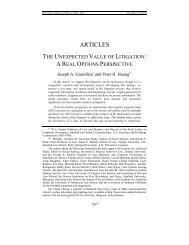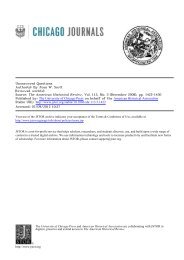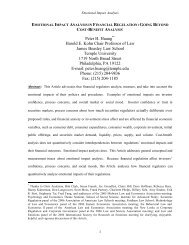Secure Implementation Experiments: Do Strategy-proof Mechanisms ...
Secure Implementation Experiments: Do Strategy-proof Mechanisms ...
Secure Implementation Experiments: Do Strategy-proof Mechanisms ...
Create successful ePaper yourself
Turn your PDF publications into a flip-book with our unique Google optimized e-Paper software.
1/20). The frequency of Nash equilibria was 65% (=13/20), the frequency of bad outcomes was<br />
10% (=2/20), and all Nash equilibrium outcomes were good, which is similar to our result.<br />
Notice that about two-thirds of the observed non-dominant strategy outcomes were<br />
Nash equilibria regardless of whether payoff tables were used. That is, deviations from<br />
dominant strategy equilibria tended to correspond to Nash equilibria in Kawagoe and Mori’s<br />
experiment, too. In itself, this provides some justification for looking at secure mechanisms.<br />
But whether the Nash equilibria that involved dominated strategies resulted in good or<br />
bad outcomes seemed to depend on whether or not payoff tables were employed. The reason<br />
why all Nash equilibria were good with payoff tables seems to be similar to that why almost all<br />
Nash equilibria were good in Treatment P, discussed in Section 6.1. If some, but not necessarily<br />
all, subjects succeed in discovering dominant strategies and the others choose best responses,<br />
then the outcome is likely to lie in the region of good Nash equilibria containing dominant<br />
strategy equilibria. The use of payoff tables would help subjects to find dominant strategies and<br />
best responses more easily. Of course further study is needed to investigate how much<br />
information on payoff structures is necessary for subjects to discover dominant strategies or<br />
play good Nash equilibria in the pivotal mechanism. This is left for future research.<br />
7. Conclusion<br />
Recent experimental and theoretical findings have raised serious questions about the<br />
viability of dominant strategy mechanisms. A possible solution is the notion of secure<br />
implementation introduced in Saijo, Sjöström and Yamato (2003). Motivated by this theoretical<br />
concept this paper presents an experimental study of the pivotal mechanism and a Groves-<br />
Clarke mechanism with single-peaked preferences. Both mechanisms are strategy-<strong>proof</strong>. But<br />
30
















